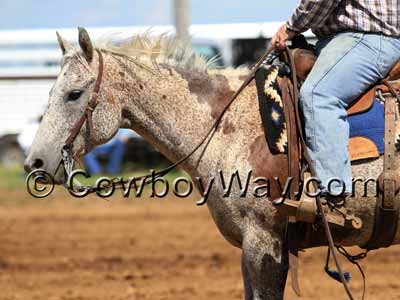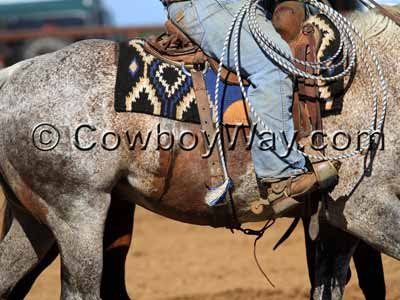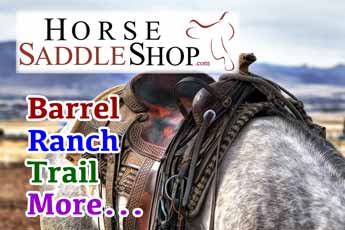What Are Horse Blood Marks?
A blood mark is a type of marking found only on flea bitten gray horses.
The area on the horse that constitutes the blood mark is not gray like the rest of the horse: Instead, it is some other color. Commonly, the blood mark areas are red (chestnut) which gives the marking its name.
Below: A flea bitten gray horse with blood marks on the neck and shoulder.

While blood marks can appear anywhere on a horse's body they are perhaps best known for appearing on the shoulder area, and are therefore sometimes also called "bloody shoulder marks." They can be called a "blood mark" or a "bloody shoulder mark" no matter where they are located.
A blood mark on a horse is usually considered to be somewhere between unusual and rare.
According to the book "Equine Color Genetics" by D. Phillip Sponenberg blood marks might increase in size as a horse ages:
"......An extremely rare occurrence is in Fig. 105, which shows patches of red color growing into the coat of a grey horse. These patches are called blood marks and can become progressively larger, resulting in a very aged grey horse that appears uniformly red."
Below: A blood mark on the side and belly of a gray horse.

Horse Blood Marks and The Color Gray
Blood marks are unique to flea bitten gray horses. If you need a refresher on gray horse coloring here is a quick overview:
- A gray horse has colored body hairs that are mixed in with white hairs.
- Most commonly, the colored body hairs are black so that when they are mixed with the white hairs the horse displays a characteristic gray color.
- As a gray horse ages the colored hairs lose their pigmentation and the horse fades to a lighter and lighter gray color. Ultimately, the horse may appear to be white.
- Flea bitten grays have dark specks scattered over a lighter base color of white. This is opposed to dapple grays which have rings of gray throughout the coat; and steel grays which are a smooth blend of dark hairs and light hairs.
You can read more about gray horses here: How To... Recognize Horse Colors - Page 1.
The blood mark areas on a horse are not gray. As stated above they are some other color, most commonly red (chestnut).
Advertisement - Enamel Running Horse Necklace / From Amazon

Blood Marks On Horses and "Somatic Mutations"
To better understand blood marks on horses it's handy to know they are a "somatic mutation." What is a somatic mutation?
- In mammals, a somatic cell is a cell that makes up the components of an animal's body (for example: skin, bones, blood, and more). A somatic cell is not responsible for reproduction (those kinds of cells are called "germ" cells).
- A mutation is a process that changes the DNA sequence of a gene. Mutations are considered to be natural, but not the norm. Some mutations are harmful while others are not.
- Somatic mutations, then, are mutations in the cells that make up the components of the body but do not include cells that can reproduce (germ cells). Somatic mutations are acquired at some point after conception, anywhere from in the womb to years after birth. They cannot be passed on to the next generation. Therefore, a horse with a blood mark may or may not produce progeny with a blood mark, but it is a characteristic that cannot be bred for.
Blood Marks and the Bedouin Mare
Blood marks, although an unusual marking on any horse, are traditionally associated with the Arabian breed. The breed originated in the great, inhospitable deserts of the Middle East and have long been prized by many different people, including the Bedouins who have made their lives in these deserts for centuries.
There is a legend about an Arabian mare owned by a Bedouin chieftain that describes how the very first blood mark came about. The following version is from Arabian Horse World magazine.
The Legend of the Bloody Shouldered Mare
As seen in the September, 1982 edition of Arabian
Horse World magazine.
Long ago on the sands of a great desert lived a Bedouin chieftain by the name of Ahmed and his tribe. In the tents of Ahmed was his most prized possession, a beautiful grey mare who was renowned throughout the desert as the fleetest and most beautiful horse in the world. Many people coveted the mare, and kings and chieftains had tried to acquire her, but Ahmed could not be persuaded to part with his beloved mare.
Ahmed decided to breed his mare, and searched the desert for a suitable mate for her. After a time, the mare was bred to the premier stallion in the Sultan's stable. Months went by and the time for the mare to foal grew near.
Riding across the desert one day, several miles from his tents, Ahmed was seen by a group of robber Bedouins. Fearing that he would lose his beloved mare as well as his life, Ahmed turned and raced toward his tents, knowing in his heart that the mare, heavy in foal, could never out-distance the bandits. The mare seemed to realize that she was running for her master's life, and slowly, very slowly, she began to gain ground on her pursuers. Shots rang out and bullets peppered the sand around them as the distance gradually widened.
They were almost out of rifle range when at last a shot rang out. A bullet pierced Ahmed's heart, and he fell forward over the neck of his beloved mare. The mare never slackened her stride, and carried her master back to his tents on their final ride together.
Ahmed's people gathered around the mare and removed his lifeless body from her back. Down one of her shoulders, his blood had dried a nasty brown in the desert heat. There the mark remained, for no one could remove it.
That night in the tent of her dead master, the mare foaled. The foal was acclaimed by all as a perfect specimen of the Arabian breed, and on his shoulder was the same rusty red mark that his dam bore.
And so it came to pass that every great horse descended from that mare carried the mark of the bloody shoulder, and it was a thing greatly prized in the desert.
What Is / Are...
… What Are 5 Of The Biggest Wild West Robberies?
… What Are 5 Reasons Horse Trailer Lighting Matters?
… What Are 8 Dumb Things To Say To A Horse Lover?
… What Are 9 Proven Ways To Keep Flies Off Horses?
… What Are Chestnuts and Ergots?
… What Are The Parts Of A Western Saddle?
… What Are Saddle Rigging Positions?
… What Are Some Fencing Options?
… What Are Some Foods Both Horses And Dogs Can Eat?
… What Are Some Horse Fencing Basics?
… What Are Some Interesting Horse Facts?
… What Are Some Interesting Charts and Graphs With Horse Information?
… What Are Some Options For Temporary Horse Fencing?
… What Are Synthetic Saddles Made Of?
… What Are The Rodeo Catch Pens?
… What Are The 10 Best 3-Horse Trailers With Living Quarters In The USA And Canada?
… What Are The X's In A Cowboy Hat?
… What Are The Three Legal Head Catches?
… What Is The Angle System For Branding?
… What Is The Barrel Racing Pattern?
… What Is A Bull Riding Vest Made Of?
… What Is Deworming Your Horse?
… What Is A Domain Name?
Why would I need one for my farm or ranch even if I don't have or
want a website?
… What Is A Fifth Wheel Trailer Hitch?
… What Is Flag and National Anthem Etiquette At A Rodeo?
… What Is A Slant Load Horse Trailer?
… What Is Floating A Horse's Teeth?
… What Do Horse Freeze Brands Look Like?
… What Is A Galvayne's Groove?
… What Is A Gooseneck Trailer Hitch?
… What Is Some History About The First National Finals Rodeo?
… What Is The History Of The Modern, Hornless, Bronc Riding Saddle?
… What Is The History Of The Modern Rodeo Bucking Chute?
… What Is The History Of The One-Hand Bareback Rigging?
… What Is The Nasolacrimal Duct In Horses?
… What Is A Pony Express Mochila?
… What Is Hermann Oak Leather?
… What Is Larvicidal De-Worming?
… What Is The Flehmen Response?
… What Is The Rodeo Return Gate?
… What Is A Safety Tip For Posting The Colors?
… What Is A Slick Fork Saddle?
… What Is A Swell Fork Saddle?
You Might Also Like
